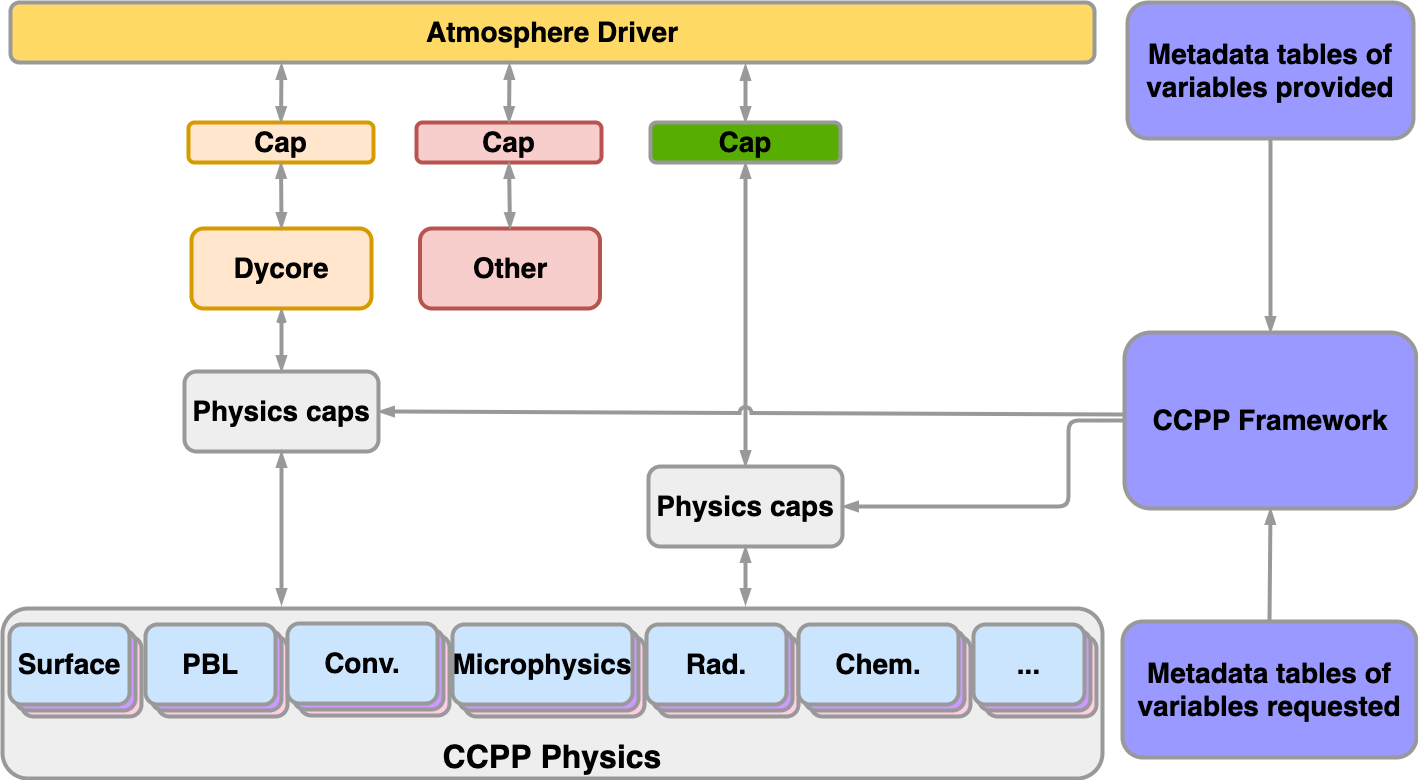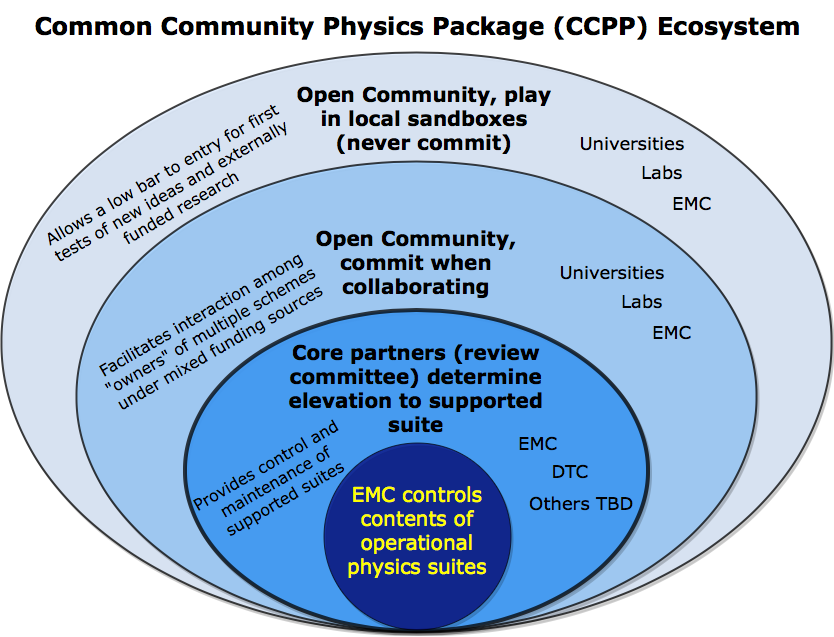1. CCPP Overview¶
Ideas for this project originated within the Earth System Prediction Capability (ESPC) physics interoperability group, which has representatives from the US National Center for Atmospheric Research (NCAR), the Navy, National Oceanic and Atmospheric Administration (NOAA) Research Laboratories, NOAA National Weather Service, and other groups. Physics interoperability, or the ability to run a given physics suite in various host models, has been a goal of this multi-agency group for several years. An initial mechanism to run the physics of NOAA’s Global Forecast System (GFS) model in other host models was developed by the NOAA Environmental Modeling Center (EMC) and later augmented by the NOAA Geophysical Fluid Dynamics Laboratory (GFDL). The CCPP expanded on that work by meeting additional requirements put forth by NOAA, and brought new functionalities to the physics-dynamics interface. Those include the ability to choose the order of parameterizations, to subcycle individual parameterizations by running them more frequently than other parameterizations, and to group arbitrary sets of parameterizations allowing other computations in between them (e.g., dynamics and coupling computations).
The architecture of the CCPP and its connection to a host model is shown in Figure 1.1. Two elements of the CCPP are highlighted: a library of physical parameterizations (CCPP-Physics) that conforms to selected standards and an infrastructure (CCPP-Framework) that enables connecting the physics to a host model. The third element (not shown) is the CCPP Single Column Model (SCM), a simple host model that can be used with the CCPP Physics and Framework.

Fig. 1.1 Architecture of the CCPP and its connection to a host model, represented here as the driver for an atmospheric model (yellow box). The dynamical core (dycore), physics, and other aspects of the model (such as coupling) are connected to the driving host through the pool of physics caps. The CCPP-Physics is denoted by the gray box at the bottom of the physics, and encompasses the parameterizations, which are accompanied by physics caps.¶
The host model needs to have functional documentation (metadata) for any variable that will be passed to or received from the physics. The CCPP-Framework is used to compare the variables requested by each physical parameterization against those provided by the host model 1, and to check whether they are available, otherwise an error will be issued. This process serves to expose the variables passed between physics and dynamics, and to clarify how information is exchanged among parameterizations. During runtime, the CCPP-Framework is responsible for communicating the necessary variables between the host model and the parameterizations.
The CCPP-Physics contains the parameterizations and suites that are used operationally in the UFS Atmosphere, as well as parameterizations that are under development for possible transition to operations in the future. The CCPP aims to support the broad community while benefiting from the community. In such a CCPP ecosystem (Figure 1.2), the CCPP can be used not only by the operational centers to produce operational forecasts, but also by the research community to conduct investigation and development. Innovations created and effectively tested by the research community can be funneled back to the operational centers for further improvement of the operational forecasts.
Both the CCPP-Framework and the CCPP-Physics are developed as open source code, follow industry-standard code management practices, and are freely distributed through GitHub (https://github.com/NCAR/ccpp-physics and https://github.com/NCAR/ccpp-framework). This documentation is housed in repository https://github.com/NCAR/ccpp-doc.

Fig. 1.2 CCPP ecosystem.¶
The CCPP is governed by the groups that contribute to its development. The governance of the CCPP-Physics is currently led by NOAA, and the DTC works with EMC and the National Weather Service Office of Science and Technology Integration to determine schemes and suites to be included and supported. The governance of the CCPP-Framework is jointly undertaken by NOAA and NCAR (see more information at https://github.com/NCAR/ccpp-framework/wiki and https://dtcenter.org/gmtb/users/ccpp).
The table below lists all parameterizations supported in CCPP and the CCPP Scientific Documentation describes the parameterizations in detail. The parameterizations are grouped in suites, which can be classified primarily as operational or experimental. There are also variants, which are suites that vary slightly from the other ones for some practical reason, such as to enable a suite even when certain fields are missing from the initial conditions. Suites are supported for use with specific host models, such as the SCM, and the versions of the UFS Weather Model used in the UFS Medium-Range Weather (MRW) Application or the UFS Short-Range Weather (SRW) Application.
Operational |
Developmental |
||||
|---|---|---|---|---|---|
Host |
SCM/MRW/SRW |
SCM/MRW |
SCM |
SCM |
SCM/SRW |
GFS_v15p2 |
GFS_v16beta |
csawmg |
GSD_v1 |
RRFS_v1alpha |
|
Microphysics |
GFDL |
GFDL |
M-G3 |
Thompson |
Thompson |
PBL |
K-EDMF |
TKE EDMF |
K-EDMF |
MYNN |
MYNN |
Deep convection |
SAS |
saSAS |
CSAW |
GF |
GF |
Shallow convection |
SAS |
saSAS |
saSAS |
MYNN and GF |
MYNN |
Radiation |
RRTMG |
RRTMG |
RRTMG |
RRTMG |
RRTMG |
Surface layer |
GFS |
GFS |
GFS |
GFS |
GFS |
Gravity Wave Drag |
uGWD |
uGWD |
uGWD |
uGWD |
uGWD |
Land surface |
Noah |
Noah |
Noah |
RUC |
Noah-MP |
Ozone |
NRL 2015 |
NRL 2015 |
NRL 2015 |
NRL 2015 |
NRL 2015 |
H2O |
NRL 2015 |
NRL 2015 |
NRL 2015 |
NRL 2015 |
NRL 2015 |
Ocean |
NSST |
NSST |
NSST |
NSST |
NSST |
The second row indicates which host model the suite is supported for. The suites that are currently supported in the CCPP are listed in the third row. The types of parameterization are denoted in the first column, where H2O represents the stratospheric water vapor parameterization. The GFS_v15p2 suite includes the GFDL microphysics, a Eddy-Diffusivity Mass Flux (K-EDMF) planetary boundary layer (PBL) scheme, scale-aware (sa) Simplified Arakawa-Schubert (SAS) convection, Rapid Radiation Transfer Model for General Circulation Models (RRTMG) radiation, the GFS surface layer, the unified gravity wave drag (uGWD), the Noah Land Surface Model (LSM), the 2015 Navy Research Laboratory (NRL) ozone and stratospheric water vapor schemes, and the NSST ocean scheme. The three developmental suites are candidates for future operational implementations. The GFS_v16beta suite is the same as the GFS_v15p2 suite except using the Turbulent Kinetic Energy (TKE)-based EDMF PBL scheme. The Chikira-Sugiyama (csawmg) suite uses the Morrison-Gettelman 3 (M-G3) microphysics scheme and Chikira-Sugiyama convection scheme with Arakawa-Wu extension (CSAW). The NOAA Global Systems Division (GSD) v1 suite (GSD_v1) includes Thompson microphysics, Mellor-Yamada-Nakanishi-Niino (MYNN) PBL and shallow convection, Grell-Freitas (GF) deep convection schemes, and the Rapid Update Cycle (RUC) LSM. Suite RRFS_v1alpha is targeted for the Rapid Refresh Forecast System (RRFS) and differs from the GSD_v1 suite by not using parameterized convection and employing the Noah-Multiparameterization (MP) LSM.
Those interested in the history of previous CCPP releases should know that the first public release of the CCPP took place in April 2018 and included all the parameterizations of the operational GFS v14, along with the ability to connect to the SCM. The second public release of the CCPP took place in August 2018 and additionally included the physics suite tested for the implementation of GFS v15. The third public release of the CCPP, in June 2019, had four suites: GFS_v15, corresponding to the GFS v15 model implemented operationally in June 2019, and three developmental suites considered for use in GFS v16 (GFS_v15plus with an alternate PBL scheme, csawmg with alternate convection and microphysics schemes, and GFS_v0 with alternate convection, microphysics, PBL, and land surface schemes). The CCPP v4.0 release, issued in March 2020, contained suite GFS_v15p2, which is an updated version of the operational GFS v15 and replaced suite GFS_v15. It also contained three developmental suites: csawmg with minor updates, GSD_v1 (an update over the previously released GSD_v0), and GFS_v16beta, which was the target suite at the time for implementation in the upcoming operational GFSv16 (it replaced suite GFSv15plus). The CCPP v4.1 release, issued in October 2020, was a minor upgrade with the capability to build the code using Python 3 (previously only Python 2 was supported). The CCPP v5.0 release, issued in February 2021, was a major upgrade to enable use with the UFS Short-Range Weather (SRW) Application and the RRFS_v1alpha suite.
- 1
As of this writing, the CCPP has been validated with two host models: the CCPP SCM and the atmospheric component of NOAA’s Unified Forecast System (UFS) (hereafter the UFS Atmosphere) that utilizes the Finite-Volume Cubed Sphere (FV3) dycore. The CCPP can be utilized both with the global and limited-area configurations of the UFS Atmosphere. CCPP v4.1.0 is the latest release compatible with the global UFS Medium-Range Weather Application. CCPP v5.0.0 is only compatible with the limited-area UFS Short-Range Weather Application. The CCPP has also been run experimentally with a Navy model. Work is under way to connect and validate the use of the CCPP-Framework with NCAR models.
1.1. Additional Resources¶
For the latest version of the released code and additional documentation, please visit the DTC Website.
Please send questions and comments to the CCPP Forum at https://dtcenter.org/forum/ccpp-user-support. When using the CCPP with the UFS, questions can also be posted in the UFS Forum at https://forums.ufscommunity.org/.
1.2. How to Use this Document¶
This document contains documentation for the Common Community Physics Package (CCPP). It describes the
Physics schemes and interstitials
Suite definition files
CCPP-compliant parameterizations
Process to add a new scheme or suite
Host-side coding
CCPP code management and governance
Parameterization-specific output
Debugging strategies
This table describes the type changes and symbols used in this guide.
Typeface or Symbol |
Meaning |
Example |
|---|---|---|
|
The names of commands,
files, and directories; |
Edit your |
Following these typefaces and conventions, shell commands, code examples, namelist variables, etc. will be presented in this style:
mkdir ${TOP_DIR}